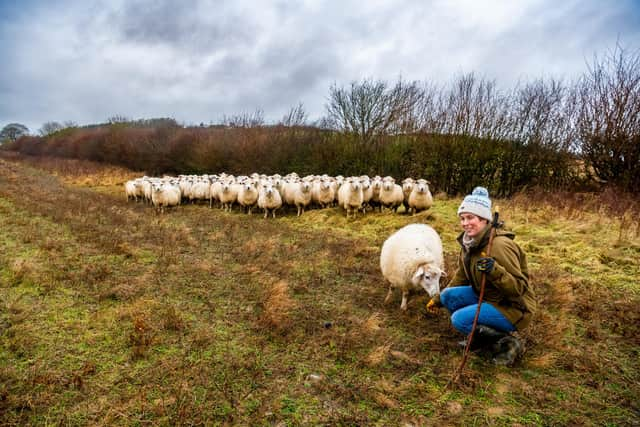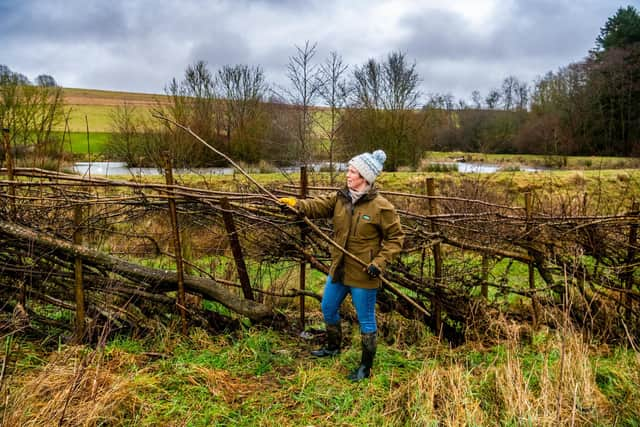Farm of the Week: Tenant farmers near Castle Howard who run hedgelaying, botany and charcoal making courses
Frances and James Standen arrived at Birkdale Farm in Mowthorpe, near Terrington under no illusions the task of making a living from farming in their own name would be challenging and set about finding the best route to ensure they could make it work.
“We wanted to have a crack at doing it by ourselves,” says Frances. “We aspired to having our own farm. When people ask about what we farm now, I say we are farming arable crops, sheep, environment and people.
Advertisement
Hide AdAdvertisement
Hide Ad“We need people to come here and to extract some value out of them whether they are buying honey, eggs or lamb. One element we have in our favour is the fantastic natural asset of this area, which is where our courses in hedgelaying, botany and, in future, art all come in.


“We both have other incomes outside of the farm, but James and I still believe the farm has to stand on its own two feet, and using our natural resources helps in bringing additional income to our farming.
“We get a lot of people coming through the farm and it is very beautiful place. Our landowner is also very committed to increasing wildlife and bird numbers and the farm is a specialist site for rare arable plants as well. We have been keen to continue that and we are committed to regenerative farming principles, including improving soil health.
While Frances and James are passionate about the environment and the beauty of the countryside, which saw them as runner up in the Tye Trophy for North Yorkshire last year they are also just as passionate about farming. It’s in their blood.
Advertisement
Hide AdAdvertisement
Hide Ad“James’ grandfather farmed and it is all he ever wanted to do. He talks, lives, breathes farming. James is from Sussex, we were at college together at Wye College, Kent.


“We went straight for a flock of Romney sheep and have 150 breeding ewes. James grew up with them. My main requirement was whatever sheep we had should be easy care.
“I’d spent five years living on a dairy farm in Cumbria when I was younger and realised I loved farming. I went down the environment route and worked in that sector for many years.
“We’re very realistic and knew that we were going to have to keep down input costs and saw that regenerative farming, sustainable mixed farming, going back to how things used to be by putting livestock back into rotation could be the answer, as well as both having part-time employment off-farm.
Advertisement
Hide AdAdvertisement
Hide Ad“Our farm has been down to 100 acres of winter wheat on rotation, which tends to be two wheats with a herbal ley as a break crop, 100 acres of grass and another 100 under various environmental options, but we are shifting to cover crops from overwintered stubbles which we had in the higher-level stewardship scheme as a result of our new mid-tier stewardship scheme involvement which we have just applied for as well as the SFI scheme.
It is the new stewardship and SFI schemes, their new rules and regulations, and the far reduced single farm payment that has accelerated Frances’ desire for following other new business threads that include such as hedgelaying courses being run currently.
“We have seen significant improvements to the soil, wildlife, insect population and wild flowers since we have been here, having gone down the direct drilling route and bringing livestock into the rotation.
“There are some issues in the ways the SFI and mid-tier schemes are pushing you that initially looked as though the good work we have done might be affected. We have a field on the farm that had been in arable reversion, so it was out of arable production through an environmental agreement.
Advertisement
Hide AdAdvertisement
Hide Ad“The intention was that it became wildflower-rich, species-rich grassland. We came in, brought the sheep in, and used them in a very targeted way to get what we wanted out of the land and to utilise their ability to get forage from grassland.
“By introducing the sheep back into the rotation and with good management, moving the sheep regularly, that field is now a riot of colour. It looks like a painting every summer and is absolutely stunning, because of the sheep, the grazing, what we have done, but under the new schemes it didn’t look as though there would be the same incentive for species-rich grassland with our move to mid-tier from what was available in higher level stewardship.
‘That would have meant we would have been financially better off to plough it up and put in a herbal ley, which obviously we were not going to do because that’s not what we believe in doing. Fortunately, this appears to now being reconsidered.
Frances says that she and James play to their strengths, and that includes the strengths of their two daughters aged 12 and 11.
Advertisement
Hide AdAdvertisement
Hide Ad“We lamb the Romneys at the Easter holidays and the girls are both very involved. Our sheep are New Zealand Romneys which had 152 per cent prolificacy last spring. It’s a closed flock. All we bring in are rams. We are breeding our own replacements, sell some as stores and to some breeders who are looking for Romneys. As we’ve now a few more herbal leys we may get a few more to fat lambs. We’ve just bought a New Zealand Suffolk ram so that we can hopefully get some more value out of our stores.
“We sell lambs at Malton livestock market and we also sell our own home-reared lamb locally to local consumers who tell us it is lamb like it used to be. That’s because ours are fed
on nothing but herbal leys and flower rich meadows.
Hedgelaying, botany, charcoal making, art, fishing and holidaymakers, as well as selling eggs and honey from the farm alongside the lamb, are just some of Frances’ many ways of the farm coming to terms with the huge gap being left by the lingering death of the farm payment scheme.
“I’ve worked with protected landscapes schemes in Kent and the Howardian Hills and it was through a FIPL scheme that we began hedgelaying with an initial hedge being laid next to a public right of way. It created such an interest amongst walkers and the community that we unearthed a need for hedgelaying courses
Advertisement
Hide AdAdvertisement
Hide Ad“We run them between January and March each year. The work we have done on the land has increased plant life and wildflowers and that has brought about the botany courses, usually held in June and early July; and we’ve recently gone into charcoal making. Our good friend and expert in country skills David Couttie leads the courses.
The Standens also have a holiday property on the farm in a renovated barn that sleeps six and they have a barn that could be hosting eco-weddings in future.
“We are trying to extract as much value as we can out of the farm in every area while remaining true to our roots,” says Frances.
www.birkdalefarm.co.uk
Comment Guidelines
National World encourages reader discussion on our stories. User feedback, insights and back-and-forth exchanges add a rich layer of context to reporting. Please review our Community Guidelines before commenting.